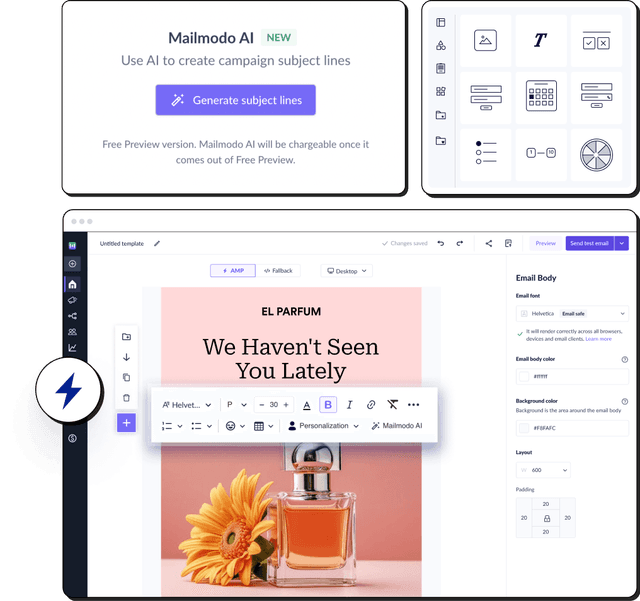What is email deliverability?
Email deliverability refers to the number of emails that reach the subscriber's inbox and don’t get filtered into the junk or spam folder. It is a key goal for every email campaign because metrics like open rates, click-through rates, and conversions only matter if your emails make it to the inbox.
The deliverability of your emails largely depends on inbox providers like Gmail, Outlook, and Yahoo. These providers assess whether your emails meet their standards and protocols. When your emails align with these requirements, they are more likely to land in the recipient’s primary inbox, ensuring high deliverability.
💡 Related guide: 5 Ways to Land Your Emails in the Inbox
Difference between email delivery and email deliverability
It's important to understand that email deliverability and email delivery are not the same, even though the two terms are often used interchangeably. The key differences are outlined below.
Email delivery refers to the successful transmission of an email to the recipient’s mail server, focusing on technical factors like valid email addresses, proper domain setup, and authentication protocols.
On the other hand, email deliverability measures whether the email actually lands in the recipient’s primary inbox, rather than being filtered into spam or promotion folders.
While delivery ensures the email reaches the server without bouncing, deliverability evaluates inbox placement, which depends on sender reputation, engagement rates, and content quality.
In short, delivery is about getting through the door, whereas deliverability is about reaching the right room.
What happens when you hit send?
Before we talk about the nitty-gritty of email deliverability, it’s crucial to understand what happens behind the scenes after you click "send."
When an email leaves the sender’s server, it passes through multiple checkpoints designed to ensure that only legitimate and relevant messages reach the inbox.
Once sent, the email encounters spam filters—powerful algorithms at the recipient’s server that evaluate the message based on factors like:
Sender legitimacy: Does the sender have a good reputation and valid authentication?
Content authenticity: Does the email contain spammy keywords or misleading information?
Domain reputation: Has the sender's domain shown trustworthy behavior in the past?
If the email checks all the boxes, it is delivered to the recipient's inbox. For Gmail users, this could mean landing in the Primary or Promotions tab. However, if it fails to meet the criteria, it may end up in the spam folder or be rejected outright by the server, leading to a bounce.

Understanding this journey is key to improving deliverability. If your emails consistently make it to the inbox—congratulations! But if not, don’t worry—we’ll explore how to overcome these challenges in the next sections.
Why is email deliverability important?
A good deliverability rate is non-negotiable to get a higher ROI from your email campaigns.
All your money and time invested in setting up your strong infrastructure, messaging, and email service provider is wasted without a solid reputation. So, email deliverability is critical to ensure you get a higher ROI.
Tracking the deliverability trends also helps you identify key email deliverability issues that might be limiting the exposure of emails to your target recipients.
The first step towards conversion is getting in the inbox, and then comes the product, the copy you've written, and the design you've created. With the best design and relevant content, if you're not inboxing, your ROI will simply go for a toss.
— Suryanarayan Pal, Growth Marketer, Mailmodo
Deliverability works like a ripple effect. A single campaign with low deliverability might cause a temporary dip in engagement, but ongoing deliverability issues can hurt your sender reputation in the long run.
Lower openness and engagement due to the bad deliverability of a single campaign won't have major long-term implications. However, continuous deliverability issues will impact your sender’s reputation, sender score, and email ROI.
💡 Related guide: A Practical Guide to Stronger Email Deliverability and Inbox Placement
What is a good email deliverability rate?
Email deliverability is vital, but measuring it accurately in real time is challenging. There’s no definitive benchmark for a “good” email deliverability rate. Unlike open or click-through rates, deliverability isn't a directly trackable metric. Instead, trends can be observed through seed list testing and related insights.
A seed list is a controlled group of email addresses used to test where your emails land—whether in inboxes, spam folders, or promotional tabs. Tools for deliverability tracking leverage these seed emails, which are added to your email list. The number of seed emails is proportional to the size of your actual list, helping gauge inbox placement.
However, deliverability testing isn’t foolproof. Variations arise due to factors like different inbox providers (e.g., Gmail, Yahoo), algorithm updates, and content filters.
So, rather than focusing on a specific "deliverability rate," it’s better to track trends over time and look for any patterns that might indicate issues. If you're consistently seeing lower-than-expected inbox placement in your seed list tests, it may be time to investigate potential deliverability problems.
What factors affect email deliverability?
ISPs are the judge of where to put marketing emails, and if they find your email worthy, they'll land it in the subscriber's inbox. However, they consider several factors in making this decision. Here’s what really matters when it comes to email deliverability:

1. Sender reputation
Sender reputation is a score assigned to an email sender by Internet Service Providers (ISPs), reflecting their trustworthiness and reliability based on factors like email engagement rates, spam complaints, bounce rates, and adherence to email-sending best practices.
The higher the score, the more ISPs will land emails in the recipient's inbox. A poor sender reputation, indicated by a score falling below an acceptable threshold, can lead ISPs to either route your emails to the spam folder or reject them entirely.
Different ISPs have their criteria to assess the sender reputation, but some of the common criteria include:
- How many legitimate emails does the organization send?
- How many recipients mark the emails as spam, complain, or unsubscribe?
- How frequently do the emails hit the ISP's spam traps?
- Is the organization's domain blacklisted?
- How many email bounces occur?
- How do recipients engage with the emails?
2. IP reputation
The numerical identifier of the sender's server is called the Internet Protocol (IP) address. Domains like mailmodo.com, gmail.com, and companyname.com are used to send emails and build a sender’s domain reputation. If the IP or domain reputation is low, ISPs are more likely to direct emails to the spam folder rather than the inbox.
The type of IP address you use - shared or dedicated will impact your deliverability.
For instance, if you use a dedicated IP address, the sending activity and campaign performance of other senders will impact your deliverability.
Gmail spam filters also look at the envelope domain's reputation to decide if an email should land in the inbox or spam.
Here's what Mailmodo and Moengage's deliverability experts have to say about the right infrastructure and its impact on deliverability.
3. Email authentication protocols
One of the key components of setting up the right email infrastructure is by following the email authentication protocols.
Email authentication conveys to your receiving server that the email is from a verified and legitimate domain, not a fraudster. Hence, email authentication is an important factor to consider so your email doesn't end up landing in a spam folder and directly reaches your subscribers' inbox.
SPF, DKIM, and DMARC are the key components that affect email deliverability in email authentication.
💡 Related guide: All You Need to Know About Email Authentication in 2025
4. Email sending frequency and volume
While setting up the email infrastructure, it's advised to warm up the IP. It's because Mailbox filters keep an eye over sending volume and frequency. If they see a sudden surge in emails sent from a domain, it will land your email in spam.
As for frequency, it must be consistent and consider what the user has opted-in. If they opted-in only for a weekly newsletter, sending promotional emails will increase your chances of landing in spam.Sudden spikes in email sending frequency or volume can raise red flags for ISPs.
5. Number of spam complaints
Spam complaints refer to the number of times a recipient marked an email as spam. Spam complaints can increase due to many reasons, including:
sending too frequent emails
sending irrelevant emails
sending emails after unsubscription
If emails get higher spam complaints, ISPs will take it as a negative sign and mark your future emails as spam emails.
6. Recipient behavior
If your emails are getting delivered to the inbox, you will still enjoy the same rate for a while. Mailbox algorithms check the recipient's actions and behaviour, asking the following questions:
Did they open the email?
Which links do they click on?
How long do they engage with the email?
Do they delete the email without opening it?
Are they unsubscribing from your emails?
A continuous negative email engagement will accumulate over time, signaling the ISPs that your emails might not be relevant to the recipient. So, going forward, your emails will land in the junk folder.
7. Subject line and content of the email
Among the big factors, the email content seems insignificant, but it still affects email deliverability.
Everything has an impact on deliverability, from your subject line and preheader text to the email footer. ISPs use spam filters to detect irrelevant or spammy content, which can land emails in the spam folder.
Some of the common things that impact deliverability include:
Spam trigger words
Link shorteners such as bit.ly
Using http:// links instead of https://
Image-only emails without any text content
Use of all-caps lock text
Too many special characters in the subject line, like Buy now!! Limited deal !!
How to ensure effective email deliverability monitoring
By keeping track of key metrics, testing strategies, and addressing potential issues proactively, you can ensure that your emails consistently reach their intended audience.
Here, we have discussed a few easy steps email marketers should take for successful email deliverability monitoring:
Apart from ESP's insights, several tools are available to help assess the health of your email program.
| Tool name |
What you can track |
| Google Postmaster Tools |
Domain reputation, IP reputation, delivery errors, spam rate, authenticated traffic, and encryption. |
| MX Toolbox |
Sender verification, IP reputation, geolocation, blacklist status, SPF/DKIM/DMARC performance, and deliverability tips. |
| MessageBird's Inbox Tracker |
Inbox placement, deliverability by ISP, domain, and campaign, average time to receive emails by domain & ISP, spam trap monitoring, blocklist monitoring, and complaint tracking. |
| Spamhaus |
Checks if your IP address is blacklisted, helping to identify and resolve deliverability issues. |
| GlockApps |
In-depth deliverability reports with seed list testing across leading ISPs, domain & IP reputation, spam filter scores, blacklisting status, authentication monitoring, content & HTML code analysis. |
There are a few other things to consider for an effective email deliverability rate.
Look for any DNS failure from the client's side as it causes changes to the authentication protocol.
Check if your email content aligns with the recipient's preferences and needs.
Check if you’re sending an email at a rate that the recipient can’t expect. Google Postmaster gives you a delivery error when you exceed the acceptable send limit.
Run email deliverability tests
There are a few tests you should run to keep track of the deliverability of email campaigns.
1. Seed list testing
Seed list testing is a crucial step in evaluating email deliverability. A seed list consists of validated and whitelisted email addresses that tools use to track where your emails land—whether in the inbox, spam, or promotional tabs. These email IDs are controlled by the sender or the tool, allowing for accurate tracking without affecting real recipients.
The size of your seed list typically scales with the size of your actual email list, providing a representative sample of your deliverability. By testing your emails across different devices and email clients, you can ensure your content performs well and reaches its intended destination in a variety of environments.
💡 Related guide: What Is a Seed List? And Create One For Email Marketing
2. Content filter testing
Content filter testing involves screening your email messages against specific filters using tools like SpamAssassin or Cloudmark. These tools evaluate your email's subject line, body content, and embedded links to identify potential spam, malware, or undesirable content.
If an email fails content filtering, it is often routed to the recipient's spam or junk folder. In some cases, depending on the filter and the severity of the content issue, the email may be rejected outright and returned to the sender with a "message undeliverable" notice.
By performing content filter testing, you can ensure your emails comply with spam filters and avoid getting blocked or flagged as spam.
Checklist to ensure higher email deliverability
Measuring the exact deliverability might be tricky. But you can watch certain signals to understand the trend of your deliverability rate and take contingent actions if it dips. Here, we have discussed pre and post-send checklists to monitor the deliverability of email campaigns:
Pre-send deliverability checklist
Check if the emails are passing SPF, DKIM & DMARC authentication protocols.
Check if your IP is on the block list.
Post-send deliverability checklist
- Keep an eye over your email analytics
DMA's Email Deliverability 2020 report shows what percentage of marketers are measuring the following metrics to monitor email deliverability:
Make sure that your domain and IP reputation in Google Postmaster should not dip suddenly.
Ensure the spam rates in Google Postmaster is less than 0.4%.
Pay special attention to any increases in unsubscribes and drops in engagement. These factors can be signs that your sending volume and frequency are no longer meeting your customers' needs and that you need to review your strategy.
— David Bitton, Co-founder & CMO, DoorLoop
Assessing the campaign's performance will help you detect exclamation points faster. So, look for these metrics to see how well your campaign performs and where you need to improve.
How to improve email deliverability
While there’s no one-size-fits-all solution for improving email deliverability, there are several actionable steps that can significantly enhance your chances of reaching your recipient’s inbox. Here’s a more practical and results-driven approach to improving your email deliverability:
1. Authenticate your domain with DKIM, DMARC, and SPF
Properly setting up DKIM, DMARC, and SPF records is essential. These protocols help inbox providers authenticate your emails, ensuring they come from a trusted source and aren’t spoofed by spammers. Authentication boosts your credibility, reducing the chances of your emails being flagged as suspicious.
2. Warm up your IP address gradually
If you’re using a new sending IP, gradually warm it up by starting with small volumes of emails and slowly increasing them over time. This helps build your IP’s reputation with inbox providers, avoiding the "spammy" look that comes with sudden high-volume email sending. Consistent engagement and low bounce rates also contribute to this process.
3. Maintain a healthy sender reputation
Regularly monitor your sender reputation through tools like Sender Score or Postmaster Tools (for Gmail) to track how inbox providers view you. High bounce rates, spam complaints, or too many unsubscribes can lower your reputation, leading to deliverability issues. If your sender reputation is dropping, it’s important to fix the issues quickly—whether it’s cleaning up your email list, reducing spam complaints, or fixing authentication issues.
4. Send relevant and engaging content
Emails with poor engagement metrics (low open and click rates, high unsubscribe rates) can trigger spam filters. Focus on sending relevant and valuable content tailored to your audience. By doing so, you increase your chances of engagement and improve your sender reputation over time. Additionally, avoid using spammy words and excessive images that can trigger filters.
5. Use confirmed opt-in for list management
Double opt-in ensures that subscribers explicitly confirm their interest in receiving emails from you. This reduces the chances of sending emails to invalid or unengaged contacts, thus improving list hygiene and reducing complaints. Clean your list regularly by removing inactive or invalid email addresses to further reduce bounce rates.
6. Encourage whitelisting
Encourage your recipients to add your email address to their whitelist or safe sender list. This ensures that your emails are less likely to be caught by spam filters. You can include instructions in your welcome email or in an ongoing campaign to help users ensure your emails always land in their inbox.
7. Monitor complaints and feedback loops
Many email service providers offer feedback loops that alert you when recipients mark your email as spam. Actively monitor and manage these complaints to ensure you’re not harming your sender reputation. If complaints spike, it’s important to take corrective actions immediately, such as revising your messaging or reducing email frequency.
8. Provide an easy unsubscribe option
If recipients can’t easily unsubscribe from your emails, they may resort to marking your emails as spam. Make the unsubscribe process clear and simple to reduce the likelihood of complaints. The goal is to allow uninterested recipients to opt out gracefully instead of negatively impacting your reputation.












